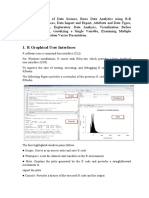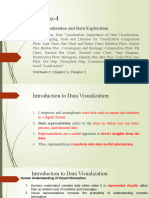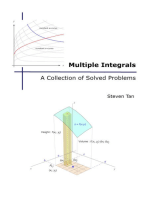0%(1)0% found this document useful (1 vote)
948 viewsUnit-6bThe Use of Motion in Segmentation
The document discusses two approaches to using motion in image segmentation: spatial techniques and frequency techniques. Spatial techniques compare pixels between two image frames taken at different times to detect changes, forming a difference image where pixels above a threshold are considered the result of object motion. Accumulative difference images can also be used by comparing each subsequent frame in a sequence to a reference frame to detect motion over multiple frames.
Uploaded by
Hruday HeartCopyright
© © All Rights Reserved
Available Formats
Download as PPTX, PDF, TXT or read online on Scribd
0%(1)0% found this document useful (1 vote)
948 viewsUnit-6bThe Use of Motion in Segmentation
The document discusses two approaches to using motion in image segmentation: spatial techniques and frequency techniques. Spatial techniques compare pixels between two image frames taken at different times to detect changes, forming a difference image where pixels above a threshold are considered the result of object motion. Accumulative difference images can also be used by comparing each subsequent frame in a sequence to a reference frame to detect motion over multiple frames.
Uploaded by
Hruday HeartCopyright
© © All Rights Reserved
Available Formats
Download as PPTX, PDF, TXT or read online on Scribd
You are on page 1/ 4
The use of Motion in segmentation
Motion is a powerful cue used by humans and many
animals to extract objects of interest from a
background of irrelevant detail.
In imaging applications, motion arises from relative
displacement between the sensing system and the
scene being viewed, such as in robotic applications,
autonomous navigation, and dynamic scene analysis
The use of motion in segmentation has
two approaches
Spatial techniques
Frequency techniques
Spatial techniques
Basic Approach: one of the simplest approaches for
detecting changes between two image frames f(x,y,ti) and
f(x,y,tj) taken at times ti and tj, respectively is to compare
the two images pixel by pixel. The procedure for doing
this is to form a difference image.
A difference image between two images taken at times ti
and tj may be defined as
Dij(x,y)= 1 if |f(x,y,ti)-f(x,y,tj)|>T
0 otherwise
T is a specified threshold
In the dynamic image processing, all pixels in dij(x,y) with value 1 are considered the
result of object motion.
Accumulative differences: Consider a sequence of image frames
f(x,y,t1),f(x,y,t2),…,f(x,y,tn) and let f(x,y,t1) be the reference image.
An Accumulative difference image (ADI) is formed by comparing this reference image
with every subsequent image in the sequence
Consider R(x,y) as reference image which is compared with f(x,y,k)
ADI are of threee types absolute, positive and negative ADIS.
AK(x,y)=Ak-1(x,y)+1 if |R(x,y)-f(x,y,k)|>T
Ak-1(x,y) otherwise
Pk(x,y)= Pk-1(x,y)+1 if |R(x,y)-f(x,y,k)|>T
Pk-1(x,y) otherwise
Nk(x,y)= Nk-1(x,y)+1 if |R(x,y)-f(x,y,K)|<-T
Nk-1(x,y) otherwise
Ak(x,t), Pk(x,y) and Nk(x,y) are the absolute , positive and negative ADIs , respectively,
after the kth image in the sequence is encountered
You might also like
- Digital Image Processing Solution of HomeworkNo ratings yetDigital Image Processing Solution of Homework7 pages
- Digital Image Proc Gonzalez Woods CH3 PPT PDF100% (1)Digital Image Proc Gonzalez Woods CH3 PPT PDF60 pages
- Assignment # II-01: Digital Image Processing (CS - 306)No ratings yetAssignment # II-01: Digital Image Processing (CS - 306)6 pages
- Image Processing (Mcae501B) Set I (Multiple Choice Type Questions)No ratings yetImage Processing (Mcae501B) Set I (Multiple Choice Type Questions)2 pages
- MA7155-Applied Probability and Statistics Question BankNo ratings yetMA7155-Applied Probability and Statistics Question Bank15 pages
- Ece Vii Image Processing (06ec756) SolutionNo ratings yetEce Vii Image Processing (06ec756) Solution73 pages
- DIP-Brightness Adaptation and Sampling Quantization100% (1)DIP-Brightness Adaptation and Sampling Quantization3 pages
- Ec8093 Dip - Question Bank With AnswersNo ratings yetEc8093 Dip - Question Bank With Answers189 pages
- Image Transforms: DFT-Properties, Walsh, Hadamard, Discrete Cosine, Haar and Slant Transforms The Hotelling TransformNo ratings yetImage Transforms: DFT-Properties, Walsh, Hadamard, Discrete Cosine, Haar and Slant Transforms The Hotelling Transform25 pages
- Image Enhancement-Spatial Filtering From: Digital Image Processing, Chapter 3No ratings yetImage Enhancement-Spatial Filtering From: Digital Image Processing, Chapter 356 pages
- Chapter 3. Intensity Transformations and Spatial FilteringNo ratings yetChapter 3. Intensity Transformations and Spatial Filtering69 pages
- Experiment No:-6: 5.1 Write A PL/SQL Code Block To Find Total and Average of 6 Subjects and Display The Grade. Ans100% (1)Experiment No:-6: 5.1 Write A PL/SQL Code Block To Find Total and Average of 6 Subjects and Display The Grade. Ans3 pages
- Image Enhancement: Images Courtesy: Digital Image Processing FOURTH EDITION, Rafael C. Gonzalez - Richard E. WoodsNo ratings yetImage Enhancement: Images Courtesy: Digital Image Processing FOURTH EDITION, Rafael C. Gonzalez - Richard E. Woods130 pages
- Functional Link Artificial Neural Network (FLANN)No ratings yetFunctional Link Artificial Neural Network (FLANN)17 pages
- Chap - 4: Screen Designing: Visually Pleasing CompositionNo ratings yetChap - 4: Screen Designing: Visually Pleasing Composition23 pages
- Prototyping: Prototyping: Prototypes and Production - Open Source Versus Closed Source0% (1)Prototyping: Prototyping: Prototypes and Production - Open Source Versus Closed Source14 pages
- Digital Image Processing 07 Image Restoration Noise RemovalNo ratings yetDigital Image Processing 07 Image Restoration Noise Removal53 pages
- Image Processing 4-ImageEnhancement (PointProcessing)No ratings yetImage Processing 4-ImageEnhancement (PointProcessing)42 pages
- Fundamental Steps in Digital Image ProcessingNo ratings yetFundamental Steps in Digital Image Processing26 pages
- Assignment # II-01: Digital Image Processing (CS - 306)Assignment # II-01: Digital Image Processing (CS - 306)
- Image Processing (Mcae501B) Set I (Multiple Choice Type Questions)Image Processing (Mcae501B) Set I (Multiple Choice Type Questions)
- MA7155-Applied Probability and Statistics Question BankMA7155-Applied Probability and Statistics Question Bank
- DIP-Brightness Adaptation and Sampling QuantizationDIP-Brightness Adaptation and Sampling Quantization
- Image Transforms: DFT-Properties, Walsh, Hadamard, Discrete Cosine, Haar and Slant Transforms The Hotelling TransformImage Transforms: DFT-Properties, Walsh, Hadamard, Discrete Cosine, Haar and Slant Transforms The Hotelling Transform
- Image Enhancement-Spatial Filtering From: Digital Image Processing, Chapter 3Image Enhancement-Spatial Filtering From: Digital Image Processing, Chapter 3
- Chapter 3. Intensity Transformations and Spatial FilteringChapter 3. Intensity Transformations and Spatial Filtering
- Experiment No:-6: 5.1 Write A PL/SQL Code Block To Find Total and Average of 6 Subjects and Display The Grade. AnsExperiment No:-6: 5.1 Write A PL/SQL Code Block To Find Total and Average of 6 Subjects and Display The Grade. Ans
- Image Enhancement: Images Courtesy: Digital Image Processing FOURTH EDITION, Rafael C. Gonzalez - Richard E. WoodsImage Enhancement: Images Courtesy: Digital Image Processing FOURTH EDITION, Rafael C. Gonzalez - Richard E. Woods
- Chap - 4: Screen Designing: Visually Pleasing CompositionChap - 4: Screen Designing: Visually Pleasing Composition
- Prototyping: Prototyping: Prototypes and Production - Open Source Versus Closed SourcePrototyping: Prototyping: Prototypes and Production - Open Source Versus Closed Source
- Digital Image Processing 07 Image Restoration Noise RemovalDigital Image Processing 07 Image Restoration Noise Removal
- Image Processing 4-ImageEnhancement (PointProcessing)Image Processing 4-ImageEnhancement (PointProcessing)
- Multiple Integrals, A Collection of Solved ProblemsFrom EverandMultiple Integrals, A Collection of Solved Problems



























































